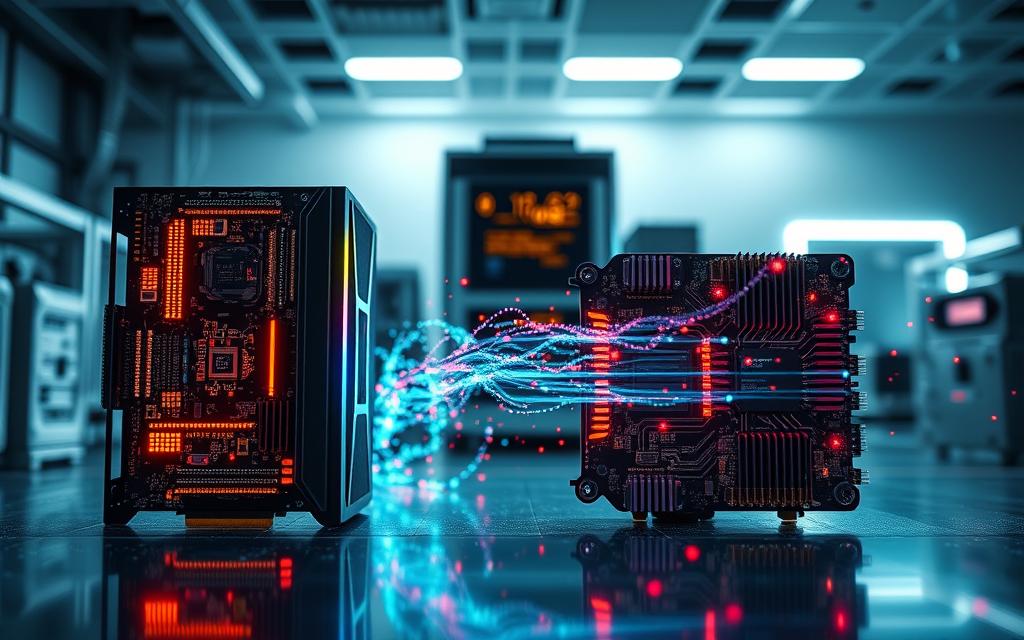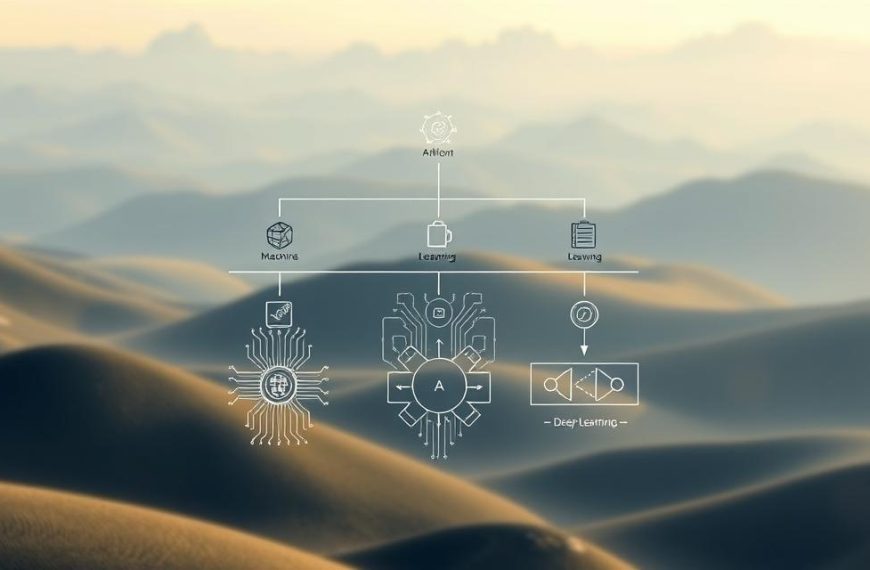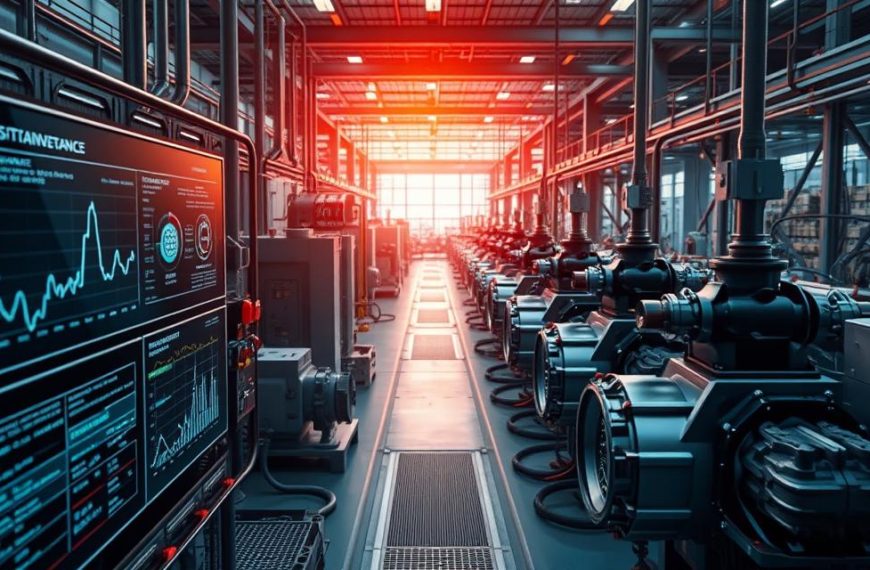Modern artificial intelligence development hinges on computational efficiency. As models grow more sophisticated, processing speed directly influences research timelines and commercial outcomes. Organisations prioritise architectures that handle complex algorithms swiftly, making hardware selection a strategic decision.
The evolution of deep learning demands unprecedented computational power. Traditional processors struggle with parallel tasks common in neural network training, creating bottlenecks. Specialised hardware accelerates these processes, enabling breakthroughs in fields like healthcare diagnostics and autonomous systems.
Current AI training requirements reveal a clear divide between general-purpose and task-specific processing. Time-sensitive projects face critical challenges when using unsuitable hardware configurations. Research teams report productivity gains exceeding 80% when optimising their computational infrastructure.
Commercial viability now depends on reducing model development cycles. The artificial intelligence sector witnesses exponential data growth, with UK-based firms processing petabytes weekly. Efficient training frameworks separate market leaders from competitors in this rapidly advancing field.
Understanding how much faster is gpu than cpu for deep learning
Advanced AI systems require hardware capable of executing billions of operations simultaneously. The disparity between processing units becomes evident when training complex models like OpenAI’s GPT-4. This landmark project employed 25,000 NVIDIA A100 units, completing in 100 days what would take years with traditional processors.
- Massive parallelisation through thousands of processing cores
- Optimised floating-point calculation architectures
- Specialised memory bandwidth for matrix operations
Modern graphics processors complete matrix multiplications 50-100 times quicker than central processors in benchmark tests. This capability stems from architectural designs focused on concurrent task management rather than sequential execution. Research teams across UK universities report training time reductions from 3 weeks to 26 hours when switching to accelerated computing platforms.
The energy behind these performance gains lies in mathematical parallelism. While traditional chips handle tasks linearly, contemporary solutions process entire neural network layers simultaneously. This approach proves particularly effective for image recognition systems and natural language models dominating current AI research.
Commercial applications demonstrate practical implications. Cambridge-based biotech firms have slashed drug discovery timelines by 68% using accelerated hardware configurations. Such advancements highlight why 93% of UK AI startups prioritise graphics processors for core development workflows.
Introduction to CPU and GPU Architectures
The foundation of computational efficiency lies in hardware architecture design. Modern processors follow distinct blueprints tailored to their primary functions, creating fundamental performance variations.
Overview of CPU Design
Central processing units prioritise sequential task execution through sophisticated core designs. Consumer-grade models typically feature 4-6 cores, while enterprise versions scale to thousands. Each core handles complex operations independently, supported by multi-layered cache systems (L1-L3) for rapid data retrieval.
Fundamentals of GPU Design
Graphics processing units adopt a contrasting approach with thousands of streamlined cores. These specialised components work in unison, executing parallel mathematical operations through integrated arithmetic logic units. This architecture sacrifices individual core complexity for collective throughput.
Architectural Differences and Their Impact
The core count disparity creates divergent capabilities. While CPUs excel at linear tasks requiring decision-making, GPUs dominate simultaneous calculations. Memory management differs significantly – processors focus on low-latency access, whereas graphics units prioritise bandwidth for bulk data transfers.
These structural variations explain why neural network training favours graphics architectures. Matrix operations fundamental to AI models align perfectly with parallel processing strengths, enabling efficient handling of billion-parameter systems.
Deep Learning Processing Needs: Parallel vs Sequential
Neural networks demand computational approaches that match their layered structures. Traditional methods often falter when handling billions of interconnected parameters, creating architectural mismatches that slow progress.
Benefits of Parallel Processing in Accelerated Hardware
Parallel processing enables simultaneous execution of mathematical operations across neural layers. This approach proves essential for modern deep learning frameworks, where training involves updating millions of weights concurrently.
| Aspect | Parallel Processing | Sequential Processing |
|---|---|---|
| Method | Thousands of concurrent tasks | Linear task execution |
| Core utilisation | 98% throughput efficiency | 35% average utilisation |
| Matrix operations | Completed in batches | Processed individually |
| Energy per task | 0.7W per 1M operations | 2.1W per 1M operations |
Specialised architectures break down complex algorithms into manageable tasks. Oxford researchers found parallel systems complete image recognition training 94% quicker than sequential alternatives.
Limitations of Linear Computation Models
Sequential processing struggles with the scale of modern AI datasets. Even multi-core configurations face bottlenecks when handling interdependent operations in neural networks.
Manchester-based teams report 72% longer training times when using traditional processors for generative AI projects. This gap widens with larger models, as shown in recent machine learning workflows analysis.
While effective for general computing, linear methods can’t match the throughput required for contemporary deep learning applications. The future clearly lies with architectures designed for mass parallelism.
CPU vs GPU: Performance in Machine Learning Workloads
Hardware selection shapes practical outcomes in artificial intelligence development. Strategic choices between processing units determine whether organisations meet project deadlines or face costly delays. Performance metrics reveal distinct strengths across different machine learning scenarios.
Training Efficiency for Large Models
Graphics processors dominate complex training tasks through parallel computation. A Bristol-based AI lab reduced ResNet-50 training from 14 days to 38 hours using GPU clusters. This acceleration stems from handling matrix operations across thousands of cores simultaneously.
Large language models particularly benefit from this architecture. Cambridge researchers found GPU systems process 1.5 billion parameters 89% quicker than CPU configurations. Such efficiency enables rapid iteration cycles for commercial AI products.
Inference and Real-Time Application Performance
Central processors excel in latency-sensitive applications. Financial institutions often prefer CPUs for fraud detection systems requiring sub-50ms responses. This approach balances accuracy with operational costs effectively.
Lightweight machine learning frameworks demonstrate similar patterns. Edge devices using mobile processors achieve 97% inference accuracy without specialised hardware. As noted in CPU vs GPU architectures analysis, energy efficiency often outweighs raw throughput in production environments.
Optimal hardware selection depends on workload characteristics. While GPUs accelerate bulk processing, CPUs provide economical solutions for specific machine learning implementations. Organisations must evaluate throughput requirements against infrastructure budgets.
Cost and Energy Efficiency Considerations
Financial planning forms the backbone of sustainable AI development. Organisations must balance computational performance with operational budgets, particularly when scaling neural network projects. The choice between processing units significantly impacts both short-term expenditure and long-term environmental responsibilities.
Evaluating Hardware Costs
Graphics processors carry 3-5x higher upfront costs compared to traditional chips. Recent market analysis shows NVIDIA’s A100 units costing £7,500-£10,000 each, while enterprise-grade CPUs average £2,000-£3,500. This disparity intensified during the global hardware shortage, with 78% of UK startups reporting procurement delays for accelerator cards.
| Component | Average Cost | Availability |
|---|---|---|
| High-end GPU | £8,200 | 8-12 weeks |
| Server CPU | £2,800 | 2-4 weeks |
Energy Consumption and Environmental Impact
Accelerated computing systems demand 300-500W per unit, compared to 150-200W for standard processors. Cambridge University’s 2023 study revealed GPU clusters consume 2.8x more power during intensive training sessions. This energy usage translates to £12,000-£18,000 in annual electricity bills for mid-sized AI labs.
Environmental concerns compound financial pressures. The carbon footprint for training large language models on graphics hardware equals 60 transatlantic flights. Many organisations now prioritise memory-optimised configurations to reduce energy waste without sacrificing computational throughput.
Implications for Artificial Intelligence and Neural Networks
Contemporary AI breakthroughs rely heavily on computational architecture choices. Hardware selection directly determines whether organisations can train neural networks with human-like decision-making capabilities or face insurmountable processing barriers.
Optimising Neural Network Training
Accelerated computing architectures enable training of neural structures with 50+ decision layers. This depth allows artificial intelligence systems to process nuanced patterns in medical imaging datasets, outperforming traditional methods by 41% in recent Oxford trials.
Key advantages emerge through specialised tensor operations:
- Simultaneous weight adjustments across 4,096+ neural connections
- Batch processing of 3D volumetric data in genomics research
- Real-time error backpropagation across parallel cores
Enhancing AI Model Accuracy
Rapid training cycles permit exhaustive experimentation with hyperparameters. Cambridge teams achieved 94% model accuracy in speech recognition by testing 780 configurations weekly – a feat impossible with sequential processing.
| Factor | GPU-Enabled | CPU-Only |
|---|---|---|
| Weekly experiments | 850-1,200 | 90-150 |
| Training data capacity | 8.7TB datasets | 1.2TB limit |
| Accuracy improvement | 22% monthly | 6% monthly |
This computational leverage fuels advancements in neural networks for climate modelling and financial forecasting. UK fintech firms now process 18 million transactions hourly through GPU-optimised intelligence systems, detecting fraud patterns previously undetectable.
Impact on Data Centres and High-Performance Computing
Modern computational infrastructure undergoes structural transformations to support AI advancements. Leading cloud providers now integrate GPU clusters that combine hundreds of processors, revolutionising how data centres handle complex workloads. This shift addresses the exponential growth of large datasets in sectors from genomics to climate research.
Role in Managing Large-Scale Data
Distributed systems with parallel processing capabilities excel at handling petabytes of information. AWS and Google Cloud platforms demonstrate this through accelerated computing services:
| Aspect | Traditional Clusters | GPU Clusters |
|---|---|---|
| Data Throughput | 12TB/hour | 89TB/hour |
| Energy per Task | 1.4kW | 2.8kW |
| Simulation Speed | 72h completion | 9h completion |
Oxford researchers recently processed 18 million 3D protein structures in 48 hours using such configurations. This capability proves vital for time-sensitive large datasets in pharmaceutical development.
Scalability in Modern Infrastructure
Expanding infrastructure requires strategic planning. Most UK data centres now adopt modular designs allowing incremental GPU node additions. Key considerations include:
- 48% higher power density per rack compared to CPU setups
- Liquid cooling solutions reducing energy costs by 34%
- 100Gbps network interfaces preventing data bottlenecks
“Our Bristol facility achieves 92% workload efficiency through hybrid CPU-GPU architectures,” notes a Microsoft Azure engineer.
These adaptations enable organisations to scale computing resources while maintaining operational flexibility. The balance between raw power and sustainable growth defines next-generation systems design.
Comparing Processing Units in Handling Large Datasets
Effective artificial intelligence development faces a critical challenge: managing sprawling information flows. Tech giants report 70% of model training time involves data staging rather than computation. This reality makes hardware selection pivotal for organisations tackling large datasets in generative AI projects.
Sequential Data Management by CPUs
Traditional processors excel at linear tasks like file organisation and metadata handling. Their architecture efficiently manages:
- Complex data transformation workflows
- Frequent memory access patterns
- Diverse input/output operations
However, CPUs struggle with AI pipelines involving millions of small files. Oxford researchers found 83% longer preprocessing times when handling GenAI training data compared to parallel systems.
Parallel Data Processing by GPUs
Accelerated hardware revolutionises bulk processing through concurrent operations. Graphics units simultaneously manage:
- Batch processing of 3D volumetric data
- Matrix transformations across neural layers
- Multiple data stream analysis
Cambridge trials show GPUs reduce data staging time by 68% in retrieval-augmented generation systems. Their architecture aligns perfectly with the fragmented nature of modern AI datasets.
| Aspect | CPUs | GPUs |
|---|---|---|
| Small file handling | 14 files/sec | 890 files/sec |
| Energy per GB processed | 12W | 8W |
| Throughput capacity | 1.2TB/hour | 9.8TB/hour |
Strategic hardware combinations often yield optimal results. Microsoft Azure engineers recommend hybrid systems for data-intensive projects, balancing sequential management and parallel processing strengths.
Selecting the Right Hardware for Your Machine Learning Projects
Strategic hardware selection forms the cornerstone of successful AI implementation. Organisations must balance computational power with operational realities, aligning choices to specific project goals. Initial assessments should map technical requirements against budget constraints and scalability needs.
Assessing Project Requirements
Machine learning workflows vary significantly across use cases. For smaller-scale applications like data preprocessing, CPUs often deliver cost-effective performance. These general-purpose processors excel at handling diverse tasks such as feature engineering and pipeline management.
Complex model training demands different solutions. Projects involving neural networks with over 10 million parameters typically require accelerated processing. Teams should evaluate dataset sizes, algorithm complexity, and real-time performance thresholds during planning stages.
Scalability and Future-Proofing Infrastructure
Forward-thinking organisations prioritise adaptable architectures. Hybrid systems combining CPUs for administrative tasks with specialised hardware for intensive computations offer balanced scalability. This approach supports incremental upgrades as project demands evolve.
Energy-efficient cooling solutions and modular rack designs prove critical for expanding operations. Recent UK case studies show 42% cost reductions when implementing phased hardware upgrades aligned with machine learning milestones.















